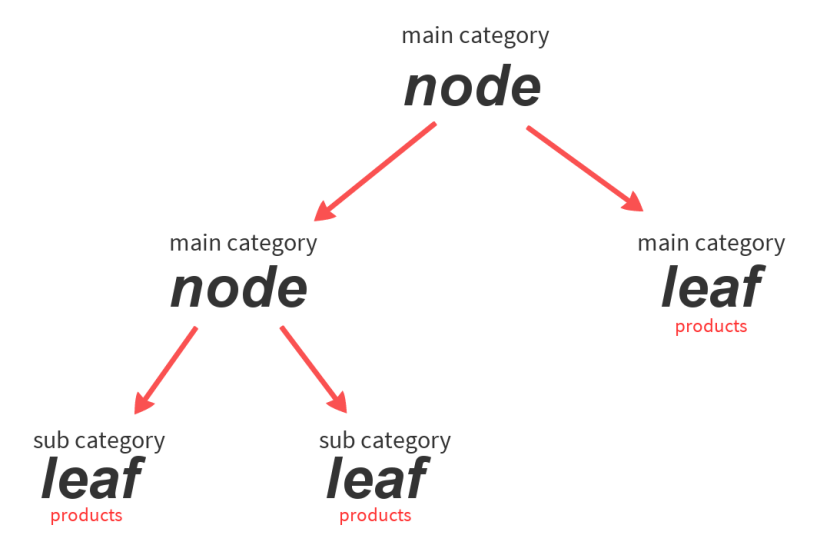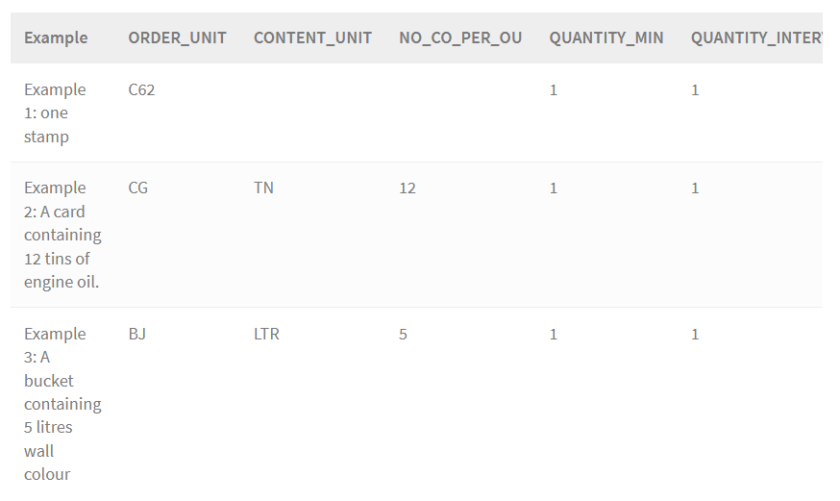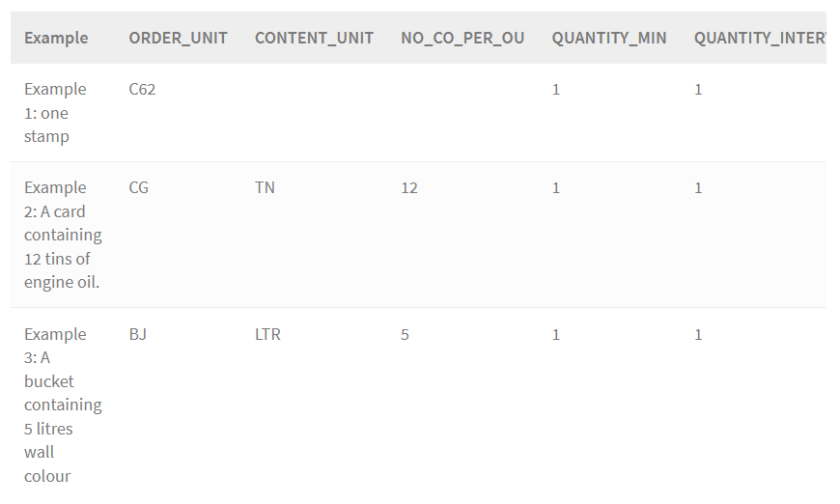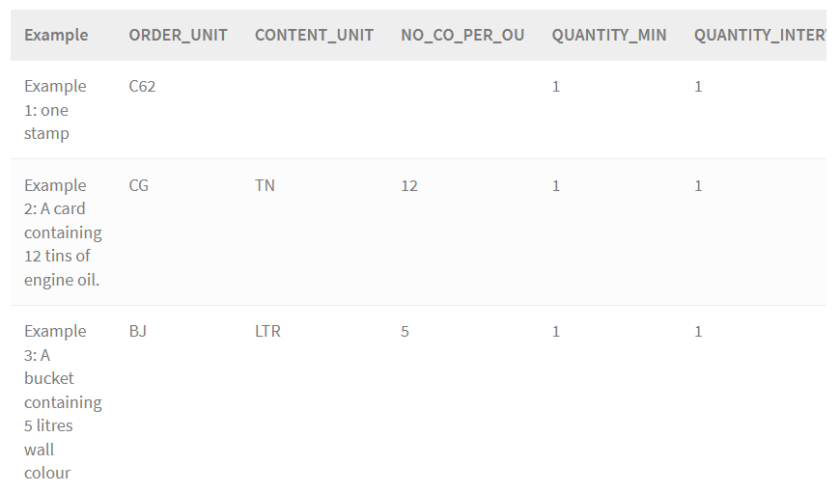On this page you will find all necessary files, tutorials and hints for creating your catalogue with the help of Mercateo templates.
Catalogue Tool – the basic process
Basically, the process to create and update a catalogue by TXT-files is divided into 4 steps:

Below all steps are explained in detail.
Step 1 - Download the templates
Besides pictures (JPG or GIF), data sheets and / or safety data sheets (PDF), a catalogue always consists of two files. One for the product information and one for the categorisation. You can download a template for these two files here:
Step 2 - Fill in the templates
Here you find detailed information about the single fields of the two TXT-files.
Categories - manual
The following explains the individual fields that appear in the file „categories_CAT-ID_LANGUAGE_UTF-8“. These are essential for the presentation of your items.
GROUP_ID is the unique ID that classifies product groups. It is used to show „father-son-relationships“. Requirements:
Row 3 always has GROUP_ID 1
Use each GROUP_ID only once
Assignment of products to GROUP_ID via CATALOG_GROUP_ID
Here you enter the name of each category. Row 3 always has the name “catalogue”. From row 4 on you enter the names for all categories and sub-categories.
Here you enter a long description for each category. This column is only applicable for manufacturer catalogues (Mercateo Brand World). For a logistics catalogue, leave the column empty. You can use paragraphs or lists to structure the description. Please use HTML tags.MIME_SOURCE.
Both colums („MIME_SOURCE“ and „MIME_PURPOSE“) are directly linked. You can add images for product categories. This column is only applicable for manufacturer catalogues (Mercateo Brand World). For a logistics catalogue, leave the column empty. If an image is available, please enter “normal” in column.
CATALOG_STRUCTURE type indicates the position of the product group within the catalogue.Requirements:
Do not delete or change row 3. It forms the root for all other (sub-)categories
For categories that contain sub-categories enter: node
For categories that contain no sub-categories enter: leaf
Products can only be allocated to categories labelled as: leaf

PARENT_ID indicates the GROUP_ID of the superordinated category. For row 3 the PARENT_ID is always 0.GROUP_ORDER.
Here you can enter a numerical value to indicate in which order sub-categories should appear within their category.
Products - manual
The following explains the individual fields that appear in the file „products_CAT-ID_LANGUAGE_UTF-8“. These are essential for the presentation of your items.
SUPPLIER_AID, also called item number, is a unique product ID for each product.Requirements:
Maximum amount of characters: 12
The item number may be used only once in the catalogue. Duplicates will be ignored and lead to an item not being displayed.
No use of special characters such as & # comma (,)
EAN/GTIN is the combination of several code schemes, e.g. EAN codes, GS1 codes or GS1. GTIN (14 characters) is formed by prefixing leading zeros from the previous EAN code. Mercateo supports both codes. EAN/GTIN must be unique within the file.DESCRIPTION_SHORT
DESCRIPTION_SHORT is a clear and illustrative description or the name of the productRequirements:
Minimum amount of characters: 10
Maximum amount of characters: 80
Should include distinctive properties such as size and colour
DESCRIPTION_LONG is a clear description of the product with precise information that define the product. Information could be item properties, product contents and further attributes.
Requirements:
Maximum amount of characters: 64,000
Include information of standards such as DIN or ISO
Pay attention to completeness
A structured description in lists and paragraphs improves legibility
For product features us FNAME (1-10)
HTML tags that influence the Mercateo layout, e.g. tables, links or <BODY> tags are prohibited
Do not use line breaks in Excel
HTML-Tags
Use the following HTML tags to structure your product data:
<B>…</B> for text in bold
<I>…</I> for text in italics
<P>…</P> for paragraphs
<BR> for line breaks
<UL><LI>…</LI></UL> for lists
MANUFACTURER_AID is the unique product ID provided by the manufacturer. It must occur only once within a catalogue. The indication of the manufacturer number has positive effects on the search result and allows the mapping of same products to duplicates.
MANUFACTURER_NAME is the manufacturer name without any legal information. The indication of the manufacturer number has positive effects on the search result and allows the mapping of same products to duplicates.
There are two different price types. Inform your supplier manager at Mercateo which price type you are going to provide.1. net Mercateo PP: use „net_list“
net Mercateo SP: use „net_customer“.
3. net Mercateo reverse auction price: use „net_customer“.
To supply 2 price types, use the 2nd column „ARTICLE_PRICE price_type“.
Here you enter the price as a value. If you supply 2 types of prices (e.g. selling price and reverse auction price), use the 2nd column „PRICE_AMOUNT“.Requirements:
Maximum of 2 decimals
Do not use thousands seperator
Enter staggered prices as follows: 1:100.99 5:98.70 10:95.50 100:90.00
Hint: Use a space to separate scales. The number before the colon indicates the scale
Here you enter the amount of order units that the PRICE_AMOUNT applies to. If you enter a value in this column, the individual unit price will be calculated by dividing the PRICE_AMOUNT by the PRICE_QUANTITY.
Is the date from when the price is valid. This is not a mandatory field.
Note: At this time, this information is not supported by Mercateo.
Is the date until when the price is valid. This is not a mandatory field.
Note: At this time, this information is not supported by Mercateo.
Requirements:
Must be indicated for each product
Must be according to ISO 4217.
Is the factor for the value-added tax. Please take care of the correct spelling, e.g. 0.19 for 19% VAT.
DELIVERY_TIME indicates the expected delivery time in working days for each product.
Requirements:
Use integer (e.g. 2 for a delivery time of 2 days)
False statements will be punished by Mercateo
ORDER_UNIT is the smallest unit of a product that can be ordered. It is possible to order multiples of the order unit.
Must be indicated for each product
Order unit and content unit must be different
Must be according to UN/CEFACT code (see table below)
Price refers to order unit or multiple of order unit
Unit | Description | Unit | Description |
4G | microlitre | KMT | kilometre |
AA | ball | KST | canister |
BE | bundle | KT | kit |
BG | bag | LBR | pound |
BJ | bucket | LTR | litre |
BL | bale | M4 | value |
BLI | blister | MC | microprogramme |
BND | bundle | MGM | milligramme |
BO | bottle | MLT | millilitre |
BX | box | MMT | millimetre |
C4 | card | MTK | square metre |
C62 | piece | MTQ | cubic metre |
CA | can | MTR | metre |
CG | card | OP | two pack |
CH | container | PA | packet |
CL | coil | PAD | pad |
CLT | centilitre | PD | pad |
CMK | square centimetre | P | pallet (lift) |
CMQ | cubic centimetre | PK | pack |
CMT | centimetre | PR | pair |
CQ | catridge | QR | quire |
CS | case | RD | rod |
CT | carton | RL | reel |
CV | cover | RM | ream |
D64 | block | RO | roll |
D97 | pallet | SA | sack |
DAY | day | SCH | box |
DI | dispenser | SET | set |
DPC | dozen piece | SPD | dispenser |
DZN | dozen | SR | strip |
EA | each | ST | sheet |
ETI | label | STK | sign |
EV | envelope | TAB | tab |
FOI | foil | TN | tin |
FOT | foot | TU | tube |
GRM | gramme | TUC | cloth |
HUR | hour | WEE | week |
JR | jar | WP | watts/peak |
KGM | kilogramme | Z3 | cask |
KIS | case |
CONTENT_UNIT is the smallest unit within an order unit. It is a mandatory field (except for C62, SET, ST and PR). Requirements:
Order unit and content unit must be different
If order unit and content unit are identically, leave this column empty
Must be according to UN/CEFACT code (see table at chapter ORDER_UNIT)
NO_CU_PER_OU is the amount of CONTENT_UNITs in an ORDER_UNIT.
Examples:

QUANTITY_MIN indicates the minimum amount of order units that must be ordered. If not minimum order quantity is indicated, the default value is one order unit.
Examples:

QUANTITY_INTERVAL indicates the interval amount at which the product can be ordered. The counting of the scale always starts with the minimum order quantity. The unit of the quantity scale is the order unit.
Examples:

Column KEYWORD contains catchwords and synonyms that help to find the product. We recommend a maximum of 10 keywords. The main term should also be added as keyword, e.g. “Copy paper”.
Please avoid:
Manufacturer names
Manufacturer numbers
EAN codes
Personal names
Verbs or linking words, e.g. with, or, and, for, from, at
Product features, e.g. white, transparent, round (For product features us FNAME (1-10)
Here you enter the GROUP_IDs of the category that the product belongs to. You define the categorisation of the catalogue in file “categories_CAT-ID_LANGUAGE_UTF-8”.
Note: Separate multiple GROUP_IDs with pipe symbol (|), e.g.
100-1000|200-1001REFERENCE_FEATURE_SYSTEM
The columns REFERENCE_FEATURE_SYSTEM_NAME and REFERENCE_FEATURE_GROUP_ID are directly linked. You can enter the name of the classification system you are using. Please indicate the version of the classification system. Mercateo supports the following classification systems:
eCl@ss one product can be assigned to multiple eCl@ss versions.
ETIM for products in the category electronics
UNSPSC an international classification system
eCl@ss
eCl@ss is offered as standard for exchanging product data between suppliers and customers. This standard is characterised by a four-level hierarchical classification key with a variety of terms from a key word register. The eCl@ss key must always consist of 8 characters. Mercateo supports eCl@ss versions 5.1.4, 6.0, 7.0, 8.0 and 9.0.
REFERENCE_FEATURE_SYSTEM_NAME | REFERENCE_FEATURE_ GROUP_ID |
ECLASS-5.1.4 | 19-02-02-02 |
ECLASS-5.1.4 | 19-02-02-02|23-04-01-02 |
ETIM
ETIM is a standard for the exchange of product information between supplier and customer for electronic products. Mercateo supports versions ETIM 2.0 to ETIM 6.0.
REFERENCE_FEATURE_SYSTEM_NAME | REFERENCE_FEATURE_ GROUP_ID | FNAME1 | FVALUE1 |
ETIM-3.0 | EC000240 | EF000010 | EV002973 |
UNSPSC
Classification according to UNSPSC is analogous to eCl@ass. Use REFERENCE_FEATURE_SYSTEM_NAME to enter the UNSPSC version and Group-ID to enter the category. Mercateo supports UNSPSC versions 7 and 13.
Customs tariff number
Customs authorities need proofs for goods that are delivered cross-border. Defined merchandise groups must be transmitted to Mercateo. Unfortunately, these IDs cannot be processed within the CSV workflow. Please contact our catalogue management to discuss the transmission of the information via an additional file.
These columns are for images, graphics and videos. The columns are directly linked. Images are displayed in a size of max. 600 x 600 pixels.
MIME_SOURCE: Enter the file name of the image and transmit the image via FTP to Mercateo
MIME_PURPOSE: Enter „normal“, if an image is available
MIME_DESCR: Describe the image as follows:
Product A, front view
Product B, detailed view
Requirements:
Minimum one clear image is required
The first image must be a representative image of the product
The image should show the product without additional features
Same images must have the same name
Send each image only once
File name must contain lower case letters only, without spaces and symbols
No logos (except for manufacturer logos as second image)
Do not use placeholders („no image“)
These columns are for product data sheets. The colums are direlctly linked.
MIME_SOURCE: Enter the file name as in your system
MIME_PURPOSE: Enter „data_sheet“, if a data sheet is available
MIME_DESCR: Enter a description of the product data sheet
Requirements:
Mercateo supports product data sheets in PDF format
The product data sheet must be in the language of the respective market
The product data sheet should represent value adding information
Same product data sheets must have the same name
File name must contain lower case letters only, without spaces and symbols
The product data sheet must be up to date
Default is one product data sheet per product
Use product name in MIME_DESCR, e.g. Product data sheet Printer XYZ
These columns are for safety data sheets. The columns are directly linked. Safety data sheets are required for all chemicals and biological products to inform the customer. The requirements are the same as for product data sheets.
MIME_SOURCE: Enter the file name as in your system.
MIME_PURPOSE: Enter „safety_data_sheet“, if a safety data sheet is available
MIME_DESCR: Enter a description of the safety data sheet ARTICLE_ORDER
Describes the order of the products within the category. Due to our search algorithm, a display cannot be ensured based on the sequence you specified ARTICLE_REFERENCE.
It is recommended to link products to other products. These references define the relationship between the products (alternative product, accessory, others). Enter item numbers in the respective column. Separate multiple item numbers with pipe symbols (|)
ARTICLE_REFERENCE type=similar | ARTICLE_REFERENCE type=accessories | ARTICLE_REFERENCE type=others |
Reference - Similar products | Reference - Accessories | Reference - Other products |
9876543271 | 9876543272 | 9876543271 | 9876543272 | 9876543272 | 9876543273 | 9876543274 |
9876543272 | 9876543273 | 9876543274 | 4566887AA |
Label | attribute | Description |
alternative product | similar | The referenced product is a similar product, with similar features that can be used as an alternative. |
accessory | accessories | The referneced product is an accessory and extends the functionality of the product. |
others | others | This column can be used if none of the other two options adequately describes the relationship between the products. |
BUYER_AID is a customer specific product number. The attribute type defines the type of the product number with the customer. This column is only applicable when you provide a framework agreement catalogue to a customer of yours via the Mercateo platform. For a catalogue on the open platform, leave the column empty.
Requirements:
Separate multiple BUYER_AIDs with pipe symbol (I)
In case of multiple use, different values of the TYPE attribute are needed.
BUYER_AID type, BUYER_AID |
Type of product; Product number definied by the customer |
ABE=2345 |
ABC=2345 | DEF=67898 |
Example:
Type “Material number”, Value “12345”
BUYER_AID type, BUYER_AID |
Material number=12345 |
ERP_GROUP_BUYER Indicates the merchandise group or material classes of the products as they are indexed in the ERP system of a customer (e.g. SAP R/3). For a catalogue on the open platform, leave the column empty.
Note: At this time, this information is not supported by Mercateo.FNAME (1-10)
Features are in addition to DESCRIPTION_LONG. A feature always contains FNAME, FVALUE and FUNIT.
FNAME: Name of the feature, e.g. Length, Colour, Hazardous material
FVALUE: Characteristic(s) of the feature. Multiple entries possible, e.g. 100, white
FUNIT: Measuring unit of the feature, e.g. mm
Requirements
Maximum amount of features = 10
Separate multiple characteristics of the feature with pipe symbol (I)
FNAME2 | FVALUE2 | FUNIT2 | FNAME3 | FVALUE3 | FUNIT3 |
Feature name 2 | Feature value 2 | Feature unite 2 | Feature name 3 | Feature value 3 | Feature unite 3 |
Colour | Red | Blue | Green | RAL | Length | 100 | 200 | 300 | cm |
Colour | Black | RAL | Length | 50 | cm |
Special note on hazardous materials
According to the Ordinance on Hazardous Substances, dangerous substances and preparations, must be clearly marked as such. Items with safety data sheets need to be marked clearly: GHS01, GHS02, GHS03, …, GHS09, or NONE. This indification is shown on the safety data sheet under point 2.
Several entries are possible. Should products with safety data sheets do not contain one of the hazardous substances mentioned under point 2, please enter NONE. If a hazardous substance exists and there is a signal word on the safety data sheet, both the hazardous substance as well as the signal word needs to be given. The safety data sheet also has to be provided.
Example 1:
An item is sold being marked “GHS02“ and the signal word “Danger“ (A).
FNAME1 | FVALUE1 | ... | FNAME2 | FVALUE2 |
GHS | GHS02 | GHSSIGNAL | A |
Example 2:
An item is sold being marked “GHS02“ and “GHS04“ and the signal word “Warning“ (G).
FNAME1 | FVALUE1 | ... | FNAME2 | FVALUE2 |
GHS | GHS02 | GHS04 | GHSSIGNAL | G |
Should products with safety data sheets do not contain one of the hazardous substances mentioned under point 2, please enter NONE as FVALUE1.
Items marked with GHS01 (exploding bomb), GHS03 (flame over circle) und GHS06 (skull with crossed bones) are excluded from sale at Mercateo. These are not allowed to be offered at Mercateo and will lead to delays during catalogue processing.
Regarding the general hazard safety guidelines, there are special requirements for marking the following product groups:
Construction foams
Adhesives
Biocidal products
Pesticides
Please refer to the documentation on the Mercateo support portal for further information.
The following shows necessary fields you must fill to create a valid catalogue version.
attribute | mandatory field |
SUPPLIER_AID | yes |
EAN | yes, for products that have one |
DESCRIPTION_SHORT | yes |
DESCRIPTION_LONG | yes |
MANUFACTURER_AID | yes |
MANUFACTURER_NAME | yes |
ARTICLE_PRICE price_type | yes |
PRICE_AMOUNT | yes |
PRICE_QUANTITY | |
DATETIME type=valid_start_date | |
DATETIME type=valid_end_date | |
PRICE_CURRENCY | yes |
TAX | yes |
DELIVERY_TIME | yes |
ORDER_UNIT | yes |
CONTENT_UNIT | yes, for products that have one |
NO_CU_PER_OU | yes, for products that have any |
QUANTITY_MIN | |
QUANTITY_INTERVAL | |
KEYWORD | |
CATALOG_GROUP_ID | yes |
ARTICLE_REFERENCE | |
REFERENCE_FEATURE_SYSTEM_NAME / REFERENCE_FEATURE_GROUP_ID | yes, for products that have any |
MIME_SOURCE (1-6) / MIME_PURPOSE (1-6) | yes, for products that have any |
FNAME (1-10) | |
MIME_SOURCE (7) | |
MIME_SOURCE (8) / MIME_PURPOSE (8) | yes, for products that have one |
ARTICLE_ORDER | |
ARTICLE_REFERENCE | |
BUYER_AID type, BUYER_AID | |
ERP_GROUP_BUYER | |
FNAME (1-10) |
Step 3 - Save them as TXT-files
Please make sure that the files meet the following requirements:
Encoding is UTF-8 or UTF-16
Delimiter is TAB or semicolon (;)
For a line break ‘Carriage Return + Line Return’ (CRLF or \r\n) must be used
Naming of the files
product-file:
products_CATALOGUE-ID_LANGUAGE_UTF-8.txt
e.g.: products_4321_eng_UTF-8.txt
category-file
categories_CATALOGUE-ID_LANGUAGE_UTF-8.txt
e.g.: categories_4321_eng_UTF-8.txt
e.g.: categories_B1234_fra_UTF-8.txt
Note:
The CATALOGUE-ID will be provided by Mercateo.
Use the LANGUAGE code according to ISO-639-2
Step 4 - Transmit both TXT-files
The TXT files are transmitted via FTP to Mercateo. Therefore you can use a client (e.g. FileZilla) or special websites.
Information how the transfer itself works can be found on this page.
Hints:
both files must be deployed at the first transmission (later on you can transmit only the file you want to update)
both files must have the same delimiter (TAB or semicolon)
Please insert the files properly named into the corresponding FTP subfolder “Catalogue ID/catalog“. Each catalogue has its own FTP directory.
The Catalogue ID in the file name should match to the name of the FTP directory.
Images and data sheets are transmitted in the FTP directories “images” and “pdf”.
After transmitting the files via FTP, Mercateo will technically check and convert them to a BMEcat automatically. This might take between 30 and 60 minutes. Afterwards, you can check your data either in the Catalogue Management Tool or the Mercateo platform.